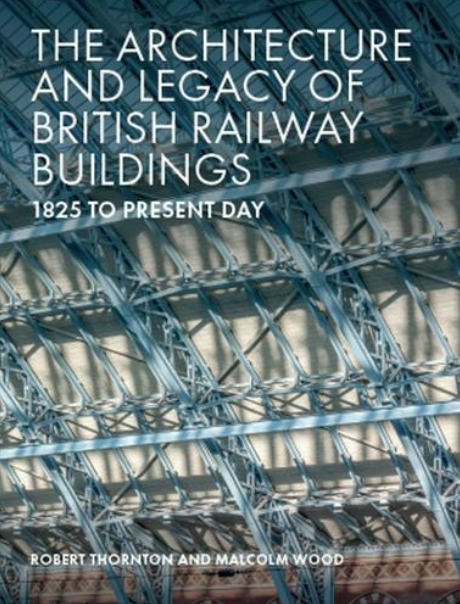The Architecture and Legacy of British Railway Buildings: 1825 to present day
The Architecture and Legacy of British Railway Buildings: 1825 to present day, Robert Thornton and Malcolm Wood, Crowood Press, 2020, 192 pages.
The great modern architect Alison Smithson wrote that railways were ‘part of the blood stream’; they ‘seeped into each of us… and made us what we are today’. This book, by two former architects to the railway industry, explores the rich built legacy of Britain’s railways. It is expertly written and beautifully illustrated.
The book has three parts. Part 1 deals with The Inheritance, Part 2, The Evolution of Railway Architecture and Part 3, Aspects of Railway Architecture. The short Part 1 includes well-informed discussion of issues surrounding the melding of an historic transport system with modern operational requirements. Of particular note is the Station Regeneration Programme, one of the benefits of which was to highlight the quality of the architectural inheritance of the railways and the role it could play in wider urban regeneration.
Part 2 deals with five identifiable railway periods, starting with the Pioneering 1825–70 years and ending with Privatisation in 1994–2019. There is good coverage of the battle of architectural styles, ranging from neo-Tudor and Jacobean confections, to pared-down classical, Italianate, gothic, baroque and charming cottage orné. The results are mainly seen in station architecture, but goods sheds, a bridge masquerading as cemetery gates and Brunel’s mighty Box Tunnel feature here as well. More detail follows from the 1870-1922 years, which embraced the Worm at Great Malvern (an enclosed passageway), the dovecote chimneys at Pantyffynon Station, the Settle and Carlisle Railway, and the need for more and ever-longer platforms as the railways expanded.
At the start of the 1947–94 Nationalisation period the rail network employed 600,000 people on 20,000 miles of track with 7,000 stations and (incredibly) 7,000 horses. But the Beeching Cuts of the 1960s, the destruction of the Euston Arch and the dire 1970s saw the nadir of Britain’s railways.
Things slowly improved and British Rail’s in-house architects designed some large (Birmingham International, 1976) and small (Winnersh Triangle, 1986) stations, culminating with Woolwich Arsenal and the remodelled Liverpool Street (the last of the BR projects designed by architects ‘standing at traditional drawing-boards’). Privatisation of the railways was controversial, but it led to investment and architecturally there is much to celebrate from this period, from the transformation of Manchester Piccadilly (in time for the Commonwealth Games) to the refurbished Gleneagles Station (in time for the Ryder Cup), and the great works at King’s Cross and St Pancras.
Part 3 provides excellent descriptions and vivid illustrations of railway architecture typology. Stations include both terminal and ‘through’, the latter exemplified by the remodelled Reading and London Bridge, both now exhilarating for those who recall their former grimness. Signal boxes, surely the most iconic of all railway structures, follow (and if you ever idly wondered where a signalman went to the loo, the answer is here).
Further text deals with locomotive maintenance facilities, railway company hotels (yeoman-like in Derby, seaside art deco in Morecambe). Train crew hostels, convalescent homes, housing for the railway workforce (think Swindon), warehouses, goods sheds (the very last, at Willesden, built as recently as the 1990s), offices, water towers, footbridges, arches, railway monuments and memorials are all covered. Building materials are discussed too, both historic and modern. The laminated timber of Manchester Oxford Road is a one-off and the illuminated glazed-brick wall at West Hampstead is a real joy.
The book ends with a wonderful miscellany concerning railway identity, livery, signage, porte-cocheres, valances (those decorative edgings to canopy roofs) and Glasgow Central’s ‘teak torpedo’ concourse buildings.
Most railway architecture has had to adapt to its predecessor. This fascinating book shows how skilfully that can be done. It also points to a future where Crossrail, HS2 and other projects will deliver an entirely new architectural legacy. Britain’s great railway journey is far from over.
This article originally appeared as: ‘Ups and downs’ in the Institute of Historic Building Conservation’s (IHBC’s) Context 172, published in June 2022. It was written by Nigel Crowe, a waterways heritage specialist. His great-grandfather was a ganger on the Great Western Railway in Somerset.
--Institute of Historic Building Conservation
Related articles on Designing Buildings
IHBC NewsBlog
Old Sarum fire in listed (& disputed) WW1 Hangar - Wiltshire Council has sought legal advice after fire engulfed a listed First World War hangar that was embroiled in a lengthy planning dispute.
UK Antarctic Heritage Trust launches ‘Virtual Visit’ website area
The Trust calls on people to 'Immerse yourself in our heritage – Making Antarctica Accessible'
Southend Council pledge to force Kursaal owners to maintain building
The Council has pledged to use ‘every tool in the toolbox’ if urgent repairs are not carried out.
HE’s Research Magazine publishes a major study of the heritage of England’s suburbs
The article traces the long evolution of an internal programme to research 200 years of suburban growth
IHBC Context 183 Wellbeing and Heritage published
The issue explores issues at the intersection of heritage and wellbeing.
SAVE celebrates 50 years of campaigning 1975-2025
SAVE Britain’s Heritage has announced events across the country to celebrate bringing new life to remarkable buildings.
IHBC Annual School 2025 - Shrewsbury 12-14 June
Themed Heritage in Context – Value: Plan: Change, join in-person or online.
200th Anniversary Celebration of the Modern Railway Planned
The Stockton & Darlington Railway opened on September 27, 1825.
Competence Framework Launched for Sustainability in the Built Environment
The Construction Industry Council (CIC) and the Edge have jointly published the framework.
Historic England Launches Wellbeing Strategy for Heritage
Whether through visiting, volunteering, learning or creative practice, engaging with heritage can strengthen confidence, resilience, hope and social connections.















